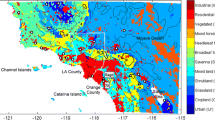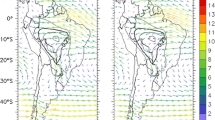Abstract
A simple mixed-layer model is developed to describe evaporation into a convective planetary boundary layer (PBL). The model comprises volume budget equations for temperature and humidity, equations to describe transport through the surface layer which is treated as part of the lower boundary, and equations to describe entrainment at the top of the PBL. The ground surface is modelled as a canopy resistance. The model was integrated with canopy resistance, surface-layer resistance and available energy, (R n − G), input as given functions of time, and the simulated PBL was allowed to grow into an atmosphere with known temperature and humidity profiles.
Two variants of the mixed-layer model were tested using data from the KNMI tower site at Cabauw in the Netherlands. These variants differed only in the formulation of entrainment: one used a formulation developed by Driedonks (1982) while the other was a simpler formulation. Simulated evaporation agreed very well with observations irrespective of which entrainment formulation was used, despite discrepancies between simulated and observed PBL height growth which were sometimes quite large for the simpler formulation. Sensitivity analysis of the model confirms that good PBL height-growth predictions are not always a prerequisite for good evaporation predictions.
Similar content being viewed by others
References
de Bruin, H. A. R.: 1983, ‘A Model for the Priestley-Taylor α’, J. Climate and Appl. Meteorol. 22, 572–578.
Carson, D. J.: 1973, ‘The Development of a Dry Inversion-Capped Convectively Unstable Boundary Layer’, Quart. J. R. Meteorol. Soc. 99, 450–467.
Deardorff, J. W.: 1983, ‘Comments on “The Daytime Planetary Boundary Layer; A New Interpretation of Wangara Data” by P. C. Manins’, Quart. J. R. Meteorol. Soc. 109, 677–681.
Driedonks, A. G. M.: 1981, ‘Dynamics of the Well-Mixed Atmospheric Boundary Layer’, Scientific Report W.R. 81–2, pp. 189. K.N.M.I., de Bilt, The Netherlands.
Driedonks, A. G. M.: 1982, ‘Models and Observations of the Growth of the Atmospheric Boundary Layer’, Boundary-Layer Meteorol. 23, 283–306.
Dyer, A. J.: 1974, ‘A Review of Flux-Profile Relationships’, Boundary-Layer Meteorol. 7, 363–372.
Garratt, J. R.: 1978, ‘Transfer Characteristics for a Heterogeneous Surface of Large Aerodynamic Roughness’, Quart. J. R. Meteorol. Soc. 104, 491–502.
Hess, G. D., Hicks, B. B., and Yamada, T.: 1981, ‘The Impact of the Wangara Experiment’, Boundary-Layer Meteorol. 20, 135–174.
Mahrt, L. and Lenschow, D. H.: 1976, ‘Growth Dynamics of the Convective Mixed Layer’, J. Atmos. Sci. 33, 41–51.
Manins, P. C.: 1982, ‘The Daytime Planetary Boundary Layer; a New Interpretation of Wangara Data’, Quart. J. R. Meteorol. Soc. 108, 689–705.
McNaughton, K. G.: 1976, ‘Evaporation and Advection II: Evaporation Downwind of a Boundary Separating Regions Having Different Surface Resistances and Available Energies’, Quart. J. R. Meteorol. Soc. 102, 193–202.
McNaughton, K. G. and Jarvis, P. G.: 1983, ‘Predicting the Effects of Vegetation Changes on Transpiration and Evaporation’, in T. T. Kozlowski (ed.) Water Deficits and Plant Growth, Vol. VII, 1–47. Academic Press, New York.
Monteith, J. L.: 1965, ‘Evaporation and Environment’, in G. E. Fogg (ed.), The State and Movement of Water in Living Organisms. Soc. Expt. Biol. Symp. No. 19, 205–234, Cambridge University Press.
Paulson, C. A.: 1970, ‘The Mathematical Representation of Wind Speed and Temperature Profiles in the Unstable Atmospheric Surface Layer’, J. Appl. Meteorol. 9, 857–861.
Penman, H. L. and Schofield. R. K.: 1951, ‘Some Physical Aspects of Assimilation and Transpiration’, in Carbon Dioxide and Photosynthesis, Soc. Expt. Biol. Symp. No. 5, 115–129. Cambridge University Press.
Perrier, A.: 1980, étude Microclimatique des Relations Entre les Propriétés de Surface et les Caractéristiques de l'Air: Application aux échanges Régionaux, Météor. Environ., EVRY (France).
Priestley, C. H. B. and Taylor, R. J.: 1972, ‘On the Assessment of Surface Heat Flux and Evaporation using Large-scale Parameters’, Mon. Weather Rev. 100, 81–92.
Sud, Y. C. and Smith, W. E.: 1984, ‘Ensemble Formulation of Surface Fluxes and Improvements in Evapotranspiration and Cloud Parameterization in a GCM’, Boundary-Layer Meteorol. 29, 185–210.
Tennekes, H.: 1973, ‘A Model for the Dynamics of the Inversion above a Convective Boundary Layer’, J. Atmos. Sci. 30, 558–567.
Author information
Authors and Affiliations
Rights and permissions
About this article
Cite this article
McNaughton, K.G., Spriggs, T.W. A mixed-layer model for regional evaporation. Boundary-Layer Meteorol 34, 243–262 (1986). https://doi.org/10.1007/BF00122381
Received:
Issue Date:
DOI: https://doi.org/10.1007/BF00122381




